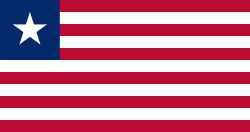Plahn Nyarn District (Plahn Nyarn District)
Plahn Nyarn District is one of the 16 districts in Sinoe County, Liberia. The distract is named after the Plain tribe and had a population of 6,805 as of the year 2008.
Written by Dr. P. Potter Pajibo
To begin with the history of the Plain tribe, it must be assumed that the Tribe had its origin from the Cavalla River (Jubu), in the eastern part of Sinoe County. It's descendancy links with the Grebo Tribe, and for this fact, the tribe is usually referred to as Bush Grebo.
The continued rift between the Grebo Tribe and the Plahn Tribe stirred up a series of intertribal wars, and the latter was forced to leave in such of a suitable place for abode under the leadership of Tarjuo, a doctor and warrior. The people of the Plahn Tribe traveled for months and at last reached a certain mountain, now called “Tarjuo Mountain”, in honor of their leader Tarjuo. He is also after whom the Tarjuozon Tribes named where they decided to settle.
The decision to make Tarjuo Mountain their home was unanimous among the people of the Plain Tribe. They settled and remained there for a few years until the death of the leader, Tarjuo.
When Tarjuo died, the Plahn Tribe people felt discouraged; and after a deep contemplation, decided to leave the Tarjuo Mountain. Because of their strong conviction in superstition, the tribal people found the mountain unsuitable to live, and felt that upon their failure to leave, they would suffer an untimely death.
Under the leadership of one of Tarjuo’s sons, Plahn, after whom the tribe is named, the group left the Tarjuo Mountain in search of another place for settlement. For months they traveled so many miles and finally reach a certain creek, called “Slae-Nee” meaning Magic Creek. This was their final destination and settlement. Tribal legend says that when they reached this area, a vision of a bright future was formed; previous conflicts and disturbances were decreased. They believed that this creek also greatly and surprisingly aided their tribe during a war between them and the Krahn people.
The main cause of the tribe’s decision to settle around the Slae-Nee Creek was for protection. Since the organization and establishment of the Plahn Tribe, the people of said tribe have been worshipping the Slae – Nee Creek as one of their tribal gods.
From the earliest memories of the tribe, the following people are said to have been some of the most outstanding leaders of the tribe; included are those who have contributed and accomplished much to its development:
* 1) Chief Jowiehfueh
Written by Dr. P. Potter Pajibo
To begin with the history of the Plain tribe, it must be assumed that the Tribe had its origin from the Cavalla River (Jubu), in the eastern part of Sinoe County. It's descendancy links with the Grebo Tribe, and for this fact, the tribe is usually referred to as Bush Grebo.
The continued rift between the Grebo Tribe and the Plahn Tribe stirred up a series of intertribal wars, and the latter was forced to leave in such of a suitable place for abode under the leadership of Tarjuo, a doctor and warrior. The people of the Plahn Tribe traveled for months and at last reached a certain mountain, now called “Tarjuo Mountain”, in honor of their leader Tarjuo. He is also after whom the Tarjuozon Tribes named where they decided to settle.
The decision to make Tarjuo Mountain their home was unanimous among the people of the Plain Tribe. They settled and remained there for a few years until the death of the leader, Tarjuo.
When Tarjuo died, the Plahn Tribe people felt discouraged; and after a deep contemplation, decided to leave the Tarjuo Mountain. Because of their strong conviction in superstition, the tribal people found the mountain unsuitable to live, and felt that upon their failure to leave, they would suffer an untimely death.
Under the leadership of one of Tarjuo’s sons, Plahn, after whom the tribe is named, the group left the Tarjuo Mountain in search of another place for settlement. For months they traveled so many miles and finally reach a certain creek, called “Slae-Nee” meaning Magic Creek. This was their final destination and settlement. Tribal legend says that when they reached this area, a vision of a bright future was formed; previous conflicts and disturbances were decreased. They believed that this creek also greatly and surprisingly aided their tribe during a war between them and the Krahn people.
The main cause of the tribe’s decision to settle around the Slae-Nee Creek was for protection. Since the organization and establishment of the Plahn Tribe, the people of said tribe have been worshipping the Slae – Nee Creek as one of their tribal gods.
From the earliest memories of the tribe, the following people are said to have been some of the most outstanding leaders of the tribe; included are those who have contributed and accomplished much to its development:
* 1) Chief Jowiehfueh
Map - Plahn Nyarn District (Plahn Nyarn District)
Map
Country - Liberia
 |
 |
| Flag of Liberia | |
Liberia began in the early 19th century as a project of the American Colonization Society (ACS), which believed black people would face better chances for freedom and prosperity in Africa than in the United States. Between 1822 and the outbreak of the American Civil War in 1861, more than 15,000 freed and free-born African Americans, along with 3,198 Afro-Caribbeans, relocated to Liberia. Gradually developing an Americo-Liberian identity, the settlers carried their culture and tradition with them. Liberia declared independence on July 26, 1847, which the U.S. did not recognize until February 5, 1862.
Currency / Language
| ISO | Currency | Symbol | Significant figures |
|---|---|---|---|
| LRD | Liberian dollar | $ | 2 |
| ISO | Language |
|---|---|
| EN | English language |















